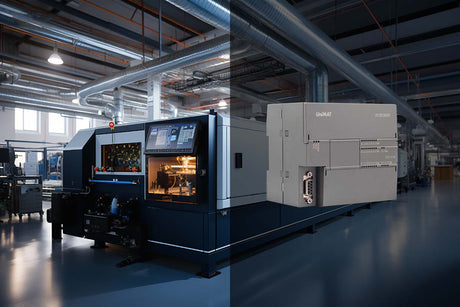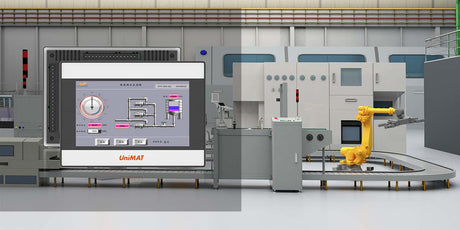En el mundo industrial automatizado de hoy, los sistemas de control PLC son la columna vertebral de la fabricación, la producción de energía y la robótica. Pero, ¿qué es exactamente un sistema de control PLC y por qué el controlador PLC es un componente tan crítico? Este artículo profundiza en cómo funcionan estos sistemas, sus aplicaciones y por qué optimizar su comprensión de los controladores PLC puede revolucionar las operaciones industriales.

Comprensión de los sistemas de control PLC
Un sistema de control de controlador lógico programable (PLC) es una computadora industrial especializada diseñada para automatizar procesos electromecánicos. A diferencia de las computadoras de uso general, los PLC están diseñados para soportar entornos hostiles como fábricas, plantas de energía o refinerías de petróleo. En el corazón de este sistema se encuentra el controlador PLC, que ejecuta comandos basados en lógica para controlar maquinaria, líneas de producción o flujos de trabajo industriales complejos.
Los componentes clave de un sistema de control PLC incluyen:
Controlador PLC : el "cerebro" que procesa las entradas y activa las salidas.
Módulos de entrada/salida (E/S): conectan sensores, interruptores y actuadores al controlador.
Fuente de alimentación: proporciona voltaje estable al sistema.
Software de programación: permite a los ingenieros escribir y cargar lógica de control (por ejemplo, lógica de escalera).
¿Cómo funciona un controlador PLC?
El controlador PLC funciona en un ciclo de escaneo continuo:
Escaneo de entrada: lee datos de sensores (por ejemplo, detectores de temperatura, presión o movimiento).
Ejecución lógica: ejecuta instrucciones programadas para determinar las acciones necesarias.
Actualización de salida: envía señales a los actuadores (por ejemplo, motores, válvulas o alarmas).
Este proceso en tiempo real garantiza precisión en tareas como la sincronización de la línea de montaje, la dosificación de productos químicos o las paradas de emergencia. Los controladores PLC modernos también admiten protocolos de comunicación (por ejemplo, Ethernet/IP, Modbus) para la integración con sistemas SCADA o dispositivos IoT.
Por qué los controladores PLC dominan la automatización industrial
Confiabilidad: Construido para funcionar 24 horas al día, 7 días a la semana en condiciones extremas con un tiempo de inactividad mínimo.
Flexibilidad: La lógica reprogramable permite adaptaciones rápidas a nuevos procesos.
Escalabilidad: Los módulos de E/S se pueden ampliar a medida que crecen las necesidades operativas.
Seguridad: Los mecanismos a prueba de fallos evitan fallos peligrosos.
Las industrias que dependen de los sistemas de control PLC incluyen:
Fabricación:Líneas de montaje, embalaje, control de calidad.
Energía: Gestión de red, sistemas de energía renovable.
Transporte:Semáforos,señalización ferroviaria.
Tratamiento de agua:Regulación de caudal,filtración.
Cómo elegir el controlador PLC adecuado
La selección de un controlador PLC depende de:
Velocidad de procesamiento: las operaciones de alta velocidad requieren CPU con ciclos de escaneo rápidos.
Capacidad de E/S:Adapte el número de entradas/salidas a su maquinaria.
Necesidades de comunicación: Soporte para IoT o conectividad en la nube.
Clasificaciones ambientales: IP67 o superior para resistencia al polvo y al agua.
Las mejores marcas como Siemens ofrecen controladores PLC especializados para diversas aplicaciones. El PLC Unimat puede ser perfectamente compatible con el PLC Siemens, con alta calidad y bajo precio. Si los clientes tienen necesidades, bienvenidos a solicitar una prueba de muestra gratuita de Unimat.
Tendencias futuras en sistemas de control PLC
Con la Industria 4.0, los controladores PLC están evolucionando:
Computación de borde: el procesamiento de datos en el dispositivo reduce la latencia.
Integración de IA: mantenimiento predictivo mediante algoritmos de aprendizaje automático.
Ciberseguridad: Protocolos mejorados para proteger los sistemas en red.

Conclusión
Un sistema de control PLC, impulsado por su controlador PLC, es indispensable para la automatización moderna. Al comprender sus funciones, aplicaciones y avances, las industrias pueden aumentar la eficiencia, reducir costos y mantenerse competitivas. Ya sea optimizando una planta de producción o innovando una infraestructura inteligente, el controlador PLC sigue siendo la piedra angular del progreso industrial.









